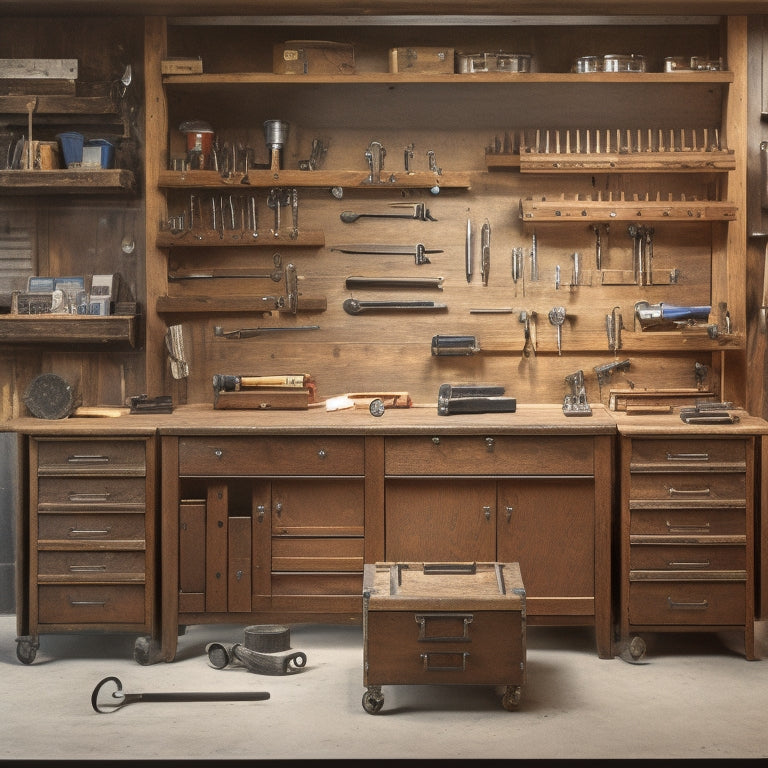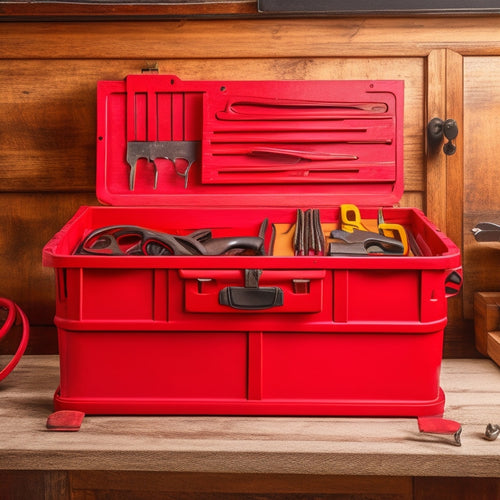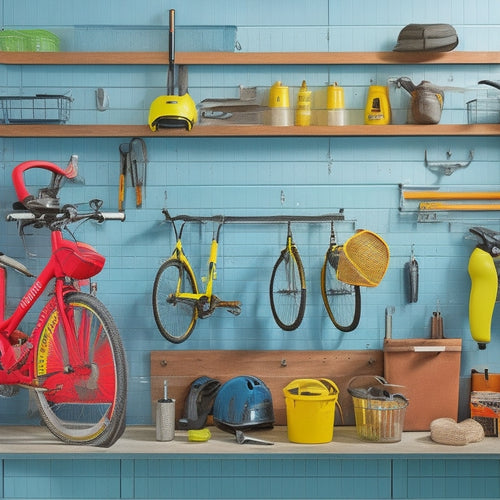
Tool Chests With Drawers for Boosting Productivity
Share
By incorporating tool chests with drawers into your workflow, you'll greatly enhance your productivity by reducing downtime spent searching for tools. With designated drawers for small parts and frequently used tools, you'll minimize interruptions during tasks and maintain a tidy workspace, lowering the risk of accidents. Customizable drawer organization, durable construction, and safety features like locking mechanisms will guarantee your tools are protected and easily accessible. By optimizing your tool storage, you'll be well on your way to maximizing your workspace productivity - and there's more to investigate when it comes to getting the most out of your tool chest investment.
Key Takeaways
- Tool chests with drawers reduce downtime by providing easy access to essential tools, enhancing focus on tasks and improving overall efficiency.
- Customizable drawer organization and clear labeling enable quick identification of tools, minimizing time spent searching and maximizing productivity.
- Strategic placement of tool chests in the workspace optimizes three key zones, reducing walking distances and fatigue while improving accessibility.
- Adjustable dividers, inserts, and shelves in tool chests enable optimal tool accessibility, reducing clutter and improving workflow efficiency.
- Durable construction and safety features in tool chests, such as locking mechanisms, ensure longevity and reduce accident risks, boosting overall productivity.
Benefits of Organized Tool Storage
With a well-organized tool chest, you can greatly reduce the time spent searching for specific tools, allowing you to focus on the task at hand. A cluttered workspace not only wastes time but also increases the risk of accidents. By implementing effective tool organization, you guarantee that your workspace tidiness is maintained, reducing the likelihood of tripping hazards and other safety risks.
Proper tool storage also helps prevent tool damage and loss. When tools are neatly arranged, you're less likely to misplace them or subject them to damage from being tossed around in a disorganized chest. This, in turn, saves you money by reducing the need for frequent replacements.
Additionally, an organized tool chest enables you to quickly identify which tools need maintenance or repair, guaranteeing that your equipment is always in good working condition. By prioritizing tool organization, you'll work more efficiently, safely, and effectively, achieving better results in less time.
Boosting Efficiency With Drawers
You'll find that tool chests with drawers enhance your efficiency by providing organized tool storage, ensuring that your most-used items are easily accessible.
With essential tools at your fingertips, you'll reduce downtime spent searching for misplaced items.
Organized Tool Storage
A well-organized tool chest with drawers is the backbone of efficient workshop operation. You know that time is money, and a cluttered workspace can lead to wasted time and energy.
With a tool organization system in place, you can quickly find what you need and get back to work.
-
Pliers, screwdrivers, and wrenches are neatly stored in designated drawers, eliminating the need to dig through a pile of tools.
-
Small parts and accessories are kept in separate compartments, preventing them from getting lost or damaged.
-
Frequently used tools are easily accessible, reducing the need to constantly open and close drawers.
-
Less frequently used tools are stored in labeled drawers, making it easy to find what you need when you need it.
-
Your workspace remains clean and clutter-free, reducing the risk of accidents and injuries.
Easy Access Essentials
Vital tools, like hammers and tape measures, are the most frequently reached-for items in your workshop. You need quick access to these tools to maintain your workflow. That's where easy access essentials come in. By storing your most-used tools in designated drawers, you can enhance your productivity and reduce fatigue.
Tool accessibility is fundamental in a workshop. When your essential tools are within easy reach, you can focus on the task at hand without interruptions. A well-organized drawer system guarantees that you can find what you need quickly, reducing downtime and increasing your overall efficiency.
Proper drawer organization is key to achieving easy access. Label each drawer clearly, and group similar tools together. This way, you can quickly identify what's inside each drawer and grab what you need in a flash.
Essential Features to Consider
Selecting the right tool chest with drawers involves careful consideration of several key factors. You want a system that streamlines your workflow, enhances productivity, and guarantees safety.
To achieve this, you need to prioritize the essential features that fit your specific needs.
When evaluating tool chests, consider the following critical aspects:
-
Drawer organization: Look for customizable compartments and dividers to keep tools organized and easily accessible.
-
Workspace layout: Verify the chest's design complements your workspace layout, allowing for efficient movement and minimizing obstacles.
-
Durability and build quality: A sturdy, well-built tool chest can withstand heavy use and harsh environments.
-
Safety features: Consider chests with secure locking mechanisms, anti-tip brackets, and other safety features that prevent accidents.
-
Mobility and ergonomics: Opt for a chest with casters or wheels, and an ergonomic design that reduces strain on your back and joints.
Maximizing Workspace Productivity
With three key zones to optimize, you can create a highly productive workspace by strategically placing your tool chest with drawers. These zones include your primary work area, secondary work area, and storage zone.
By placing your tool chest in a way that minimizes walking distances and maximizes accessibility, you can reduce fatigue and increase efficiency.
Proper workspace ergonomics is vital in preventing injuries and enhancing productivity. Verify your tool chest is at a comfortable height, allowing you to work without straining your back or neck.
Clutter reduction is also important, as a cluttered workspace can lead to accidents and decreased productivity. Store frequently used tools in easy-to-reach drawers, and reserve less frequently used tools for higher or lower drawers.
Top Tool Chest Materials
When it comes to tool chests with drawers, the material you choose can make all the difference in durability and functionality.
You want a tool chest that can withstand the rigors of daily use and keep your tools organized and within reach.
When deciding between steel vs. plastic, consider the following top tool chest materials:
-
Durable Steel: Provides exceptional strength and resistance to corrosion, ensuring your tool chest remains sturdy for years to come.
-
Heavy-Duty Aluminum: Offers a lightweight yet strong alternative to steel, perfect for those who need a portable tool chest.
-
Reinforced Plastic: A cost-effective option that still provides adequate protection for your tools, ideal for smaller workshops or DIY projects.
-
Powder-Coated Metal: A durable, rust-resistant finish that adds an extra layer of protection to your tool chest.
-
Water-Resistant Composite: A hybrid material that combines the benefits of steel and plastic, ideal for workshops exposed to moisture.
Customizable Drawer Configurations
By the time you've chosen your ideal tool chest material, you're ready to configure the drawers to fit your specific needs. Customizable drawer configurations allow you to optimize your tool organization and workflow. You can create custom layouts that cater to your unique requirements, ensuring that frequently used tools are easily accessible and less-used items are stored efficiently.
Adjustable dividers enable you to segment your drawers into compartments of varying sizes, accommodating tools of different shapes and sizes. This feature also prevents tools from getting jumbled or damaged during storage.
You can further customize your drawer configuration by adding inserts, such as foam organizers or tool trays, to create a personalized storage solution. With customizable drawer configurations, you can maximize your tool chest's storage capacity, reduce clutter, and increase productivity.
Tool Chest Size and Capacity
You've optimized your tool chest's drawer configuration to fit your specific needs. Now it's time to contemplate the overall size and capacity of your tool chest. This is essential as it directly affects the storage capacity and accessibility of your tools.
A tool chest that's too small won't hold all your essentials, while one that's too large may be cumbersome and waste important space.
When considering the size of your tool chest, think about the following factors:
- Compact units for small workshops or limited space, with dimensions around 24" x 12" x 30"
- Mid-size chests for general-purpose use, with dimensions around 36" x 18" x 42"
- Large-capacity chests for heavy-duty users, with dimensions around 48" x 24" x 60"
- Tool chests with adjustable shelves to accommodate tools of varying sizes
- Chests with deep drawers for storing bulky items like power tools or equipment
Mobility and Portability Options
With your tool chest's size and capacity determined, it's now vital to think about how easily you can move it around your workshop or job site. You need a portable tool chest that allows you to effortlessly transport your tools and equipment to different areas of your work environment.
Look for tool chests with sturdy wheels, casters, or handles that can support the weight of your tools and withstand regular use. Consider mobile workstations with adjustable heights and tilting drawers to guarantee you can access your tools comfortably, even in confined spaces.
A portable tool chest with a compact footprint is ideal for small workshops or job sites with limited space. Verify the tool chest is designed with safety features, such as locking mechanisms and secure latches, to prevent accidental openings and tool spills during transport.
Integrating With Existing Systems
When you integrate your tool chest with drawers into your existing systems, you'll want to guarantee seamless system connection, allowing you to access and update information in real-time.
Efficient data sharing is also essential, as it enables you to track tool usage and maintenance across different departments or locations.
Seamless System Connection
Tool chests with drawers can greatly enhance your workshop's organization and productivity, but their full potential is only realized when they seamlessly integrate with your existing systems.
This integration is essential for workflow optimization, as it enables you to streamline your processes and reduce downtime.
When you achieve seamless system connection, you can:
- Access tools and materials quickly and efficiently, reducing the time spent searching for them
- Automate tasks and workflows, minimizing the risk of human error
- Monitor and control inventory levels, ensuring you always have the right tools and materials on hand
- Track tool maintenance and calibration, ensuring they're always in good working order
- Integrate with other systems, such as inventory management and project management software, for a more thorough view of your operations
Efficient Data Sharing
By integrating your tool chest with drawers into existing systems, you'll release the full potential of efficient data sharing, allowing seamless communication between your workshop's various components. This integration enables data collaboration, guaranteeing that all team members have access to the same information, reducing errors and miscommunication.
| System Integration | Benefits | Results |
|---|---|---|
| Inventory Management | Real-time tracking of tools and materials | Reduced stockouts and overstocking |
| Work Order Management | Automated assignment and tracking of tasks | Increased productivity and accountability |
| Quality Control | Standardized inspection and reporting procedures | Improved quality and reduced rework |
| Supply Chain Management | Streamlined procurement and delivery processes | Faster turnaround times and cost savings |
| Reporting and Analytics | Centralized data analysis and visualization | Data-driven decision making and process optimization |
With efficient data sharing, you can guarantee that information is accessible to those who need it, when they need it. This leads to improved collaboration, increased productivity, and enhanced safety in the workshop.
Streamlined Workflow Integration
Most workshops already have existing systems in place to manage various aspects of their operations.
When introducing a new tool chest with drawers, it's crucial to integrate it with these systems to maintain workflow optimization. You'll want to guarantee seamless tool accessibility and minimize disruptions to your daily routine.
To achieve streamlined workflow integration, consider the following:
-
Centralized storage: Designate a specific area for the tool chest, guaranteeing easy access and reducing clutter in high-traffic zones.
-
Labeling and signage: Clearly label each drawer and tool, making it simple for team members to find what they need quickly.
-
Tool assignment: Assign specific tools to each team member or project, promoting accountability and reducing lost or misplaced items.
-
Regular inventory checks: Schedule regular inventory checks to identify missing or damaged tools, guaranteeing your workshop remains well-stocked and efficient.
-
Training and onboarding: Provide thorough training on the new tool chest and its integration with existing systems, facilitating a smooth shift for your team.
Maintenance and Durability Tips
Several factors contribute to the longevity of your tool chest with drawers, and a well-maintained unit can efficiently serve you for years to come. To guarantee your tool chest remains in top condition, establish a regular maintenance schedule. This should include monthly inspections for signs of wear and tear, as well as routine cleaning to prevent dust and debris buildup.
| Maintenance Tasks | Frequency |
| Inspect drawer slides and rollers | Monthly |
| Clean exterior and interior surfaces | Bi-Monthly |
| Lubricate drawer slides and hinges | Quarterly |
| Check for loose screws and bolts | Semi-Annually |
| Perform durability testing (e.g., load testing) | Annually |
Frequently Asked Questions
Can Tool Chests With Drawers Be Used for Non-Industrial Purposes?
You can repurpose tool chests with drawers for non-industrial uses, like home organization, by utilizing their creative storage capabilities to stow away items like art supplies, craft materials, or even kitchen utensils, keeping your space organized and safe.
Are Tool Chests With Drawers Suitable for Small Workshops or Garages?
Are you tired of cluttered workspaces? You'll find that tool chests with drawers are perfect for small workshops or garages, offering space efficiency and organization benefits that let you focus on the task at hand, safely and efficiently.
Do Tool Chests With Drawers Require Special Installation or Assembly?
When buying a tool chest with drawers, you'll need to check the installation requirements, as some may need anchoring to the floor or wall for stability, and follow assembly tips to guarantee a safe and secure setup.
Can I Add Custom Labels or Signs to My Tool Chest Drawers?
You can easily add custom labels or signs to your tool chest drawers, enhancing drawer organization and efficiency; use adhesive labels, magnetic signs, or engraved tags to create a personalized system that suits your specific needs.
Are Tool Chests With Drawers Compatible With Different Tool Brands?
Don't worry, you won't be limited to one brand; most tool chests with drawers are designed to accommodate various tool brands, allowing you to maximize your drawer organization and customize your setup for ideal efficiency.
Conclusion
You've streamlined your workspace with a tool chest that's a showcase in organization. Now, your tools are at your fingertips, and your workflow is humming along like a well-oiled machine. With your new setup, you're saving time, reducing frustration, and amplifying your productivity. It's a harmonious union of form and function, where every minute counts and every task is a breeze. Your workspace has evolved into a productivity powerhouse, and you're the conductor orchestrating it all.
Related Posts
-

Portable Tool Chest Essentials
When stocking your portable tool chest, you'll want to prioritize essential hand tools like hammers, tape measures, a...
-

Benefits of Pegboard Racks in Your Garage
By installing a pegboard rack in your garage, you'll reveal a wealth of benefits that change your workspace into a hi...
-

Best Tool Hooks for Garage Organization
When choosing the best tool hooks for your garage organization, you'll want to evaluate factors like weight capacity,...


